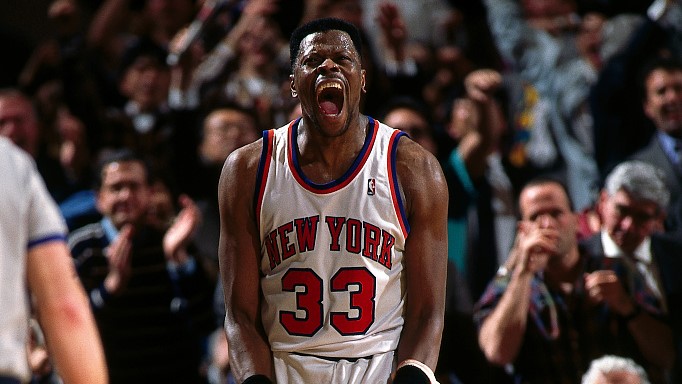
Patrick Ewing of the New York Knicks reacts in the game at Madison Square Garden in New York City, 1995. /VCG
Patrick Ewing of the New York Knicks reacts in the game at Madison Square Garden in New York City, 1995. /VCG
Patrick Ewing may be the most unfortunate of the top four centers in the 1990s. He never won a championship – Olajuwon had two, O'Neal had four and David Robinson had two; Ewing was never named MVP – Olajuwon was the 1994 NBA MVP and two-time Finals MVP; O'Neal was the 2000 NBA MVP and three-time Finals MVP; even Robinson was the 1995 NBA MVP.
The comparison doesn't end there. Ewing was only named to the All-NBA First Team once in his career – Olajuwon was on six, O'Neal eight and Robinson four. Though Ewing and his New York Knicks was well-known for their defense, Ewing himself never won the Defensive Player of the Year award – both Olajuwon and Robinson did. In fact, Ewing was only named the All-Defensive Second Team three times, the same as O'Neal.
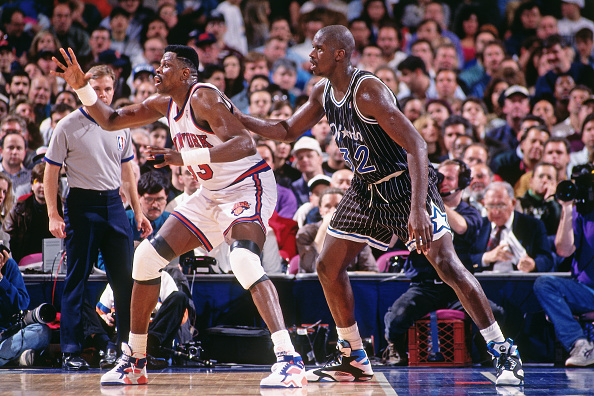
Shaquille O'Neal #32 of the Orlando Magic defends Patrick Ewing of the New York Knicks in the game at Madison Square Garden, 1993. /VCG
Shaquille O'Neal #32 of the Orlando Magic defends Patrick Ewing of the New York Knicks in the game at Madison Square Garden, 1993. /VCG
Come on, do you really want to compare Ewing's defense to that of O'Neal?
Besides the fact that the four great giants had to share half of their careers in the same league where there were not enough honors to go around, Ewing has another reason to defend himself. In his 17-season career, Ewing met Michael Jordan in the playoffs five times and lost in all of them.
By contrast, Olajuwon was in the Western Conference, never met Jordan in the playoffs and won his two titles while Jordan went to play baseball; Robinson was in the West to and never led his team to the Finals by himself; O'Neal defeated Jordan once in the playoffs when the NBA G.O.A.T was still rusty from baseball and immediately was swept 4-0 by Jordan the following year.
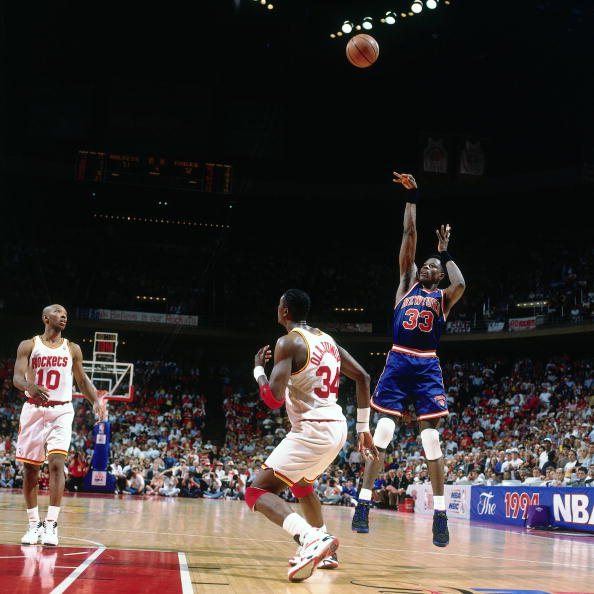
Patrick Ewing #33 of the New York Knicks shoots the ball in Game 2 of the NBA Finals against the Houston Rockets at The Summit in Houston, Texas, June 10, 1994. /VCG
Patrick Ewing #33 of the New York Knicks shoots the ball in Game 2 of the NBA Finals against the Houston Rockets at The Summit in Houston, Texas, June 10, 1994. /VCG
So what kind of player was Patrick Ewing?
The NBA actually never saw Ewing at his best because he broke his right knee during his rookie season. Considering that he suffered similar injuries several times in Georgetown, it's understandable that Ewing often talked about how he missed the athleticism he used to have.
However, Ewing averaged 2.5 blocks per game in his career and that included the three seasons after a severe Achilles tendon injury ruined most of his athleticism. Before that, Ewing surpassed three blocks per game in five seasons and reached four in 1989-90. In the seven games of the 1994 NBA Finals, Ewing delivered a total of 30 blocks facing Olajuwon.
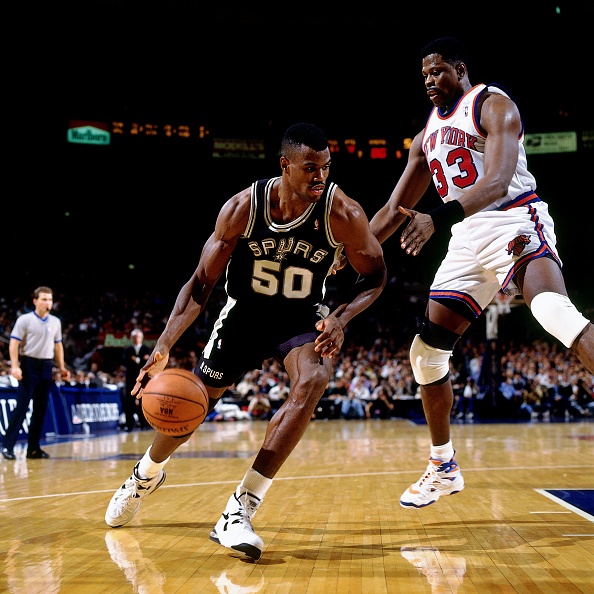
Patrick Ewing #33 of the New York Knicks defends David Robinson of the San Antonio Spurs in the game at Madison Square Garden, November 21, 1994. /VCG
Patrick Ewing #33 of the New York Knicks defends David Robinson of the San Antonio Spurs in the game at Madison Square Garden, November 21, 1994. /VCG
Ewing was explosive enough to get an in-your-face dunk from time to time, but his signature offensive move was his jump shot, probably the best in history for centers. His 2.13-meter-height, 2.43-meter-wingspan made his jumper hard to defend. Meanwhile, Ewing's strong and had solid lower body enabled him to complete his move while tussling with his rival.
Ewing was also underrated in his speed. Though he did not share the athleticism of Olajuwon or Robinson (no one did), Ewing was very dangerous when he penetrated while facing the rim – imagine his as a taller and stronger Amar'e Stoudemire. When Ewing posted up, he could step back to shoot, shoot after a baseline spin or drive into the paint while keeping his defender behind with his shoulder.
Simply speaking, Ewing, not Olajuwon, should be the textbook for center skills because all giants could learn what Ewing could do via hard work, but no big guy is like Olajuwon who's a small forward at heart.
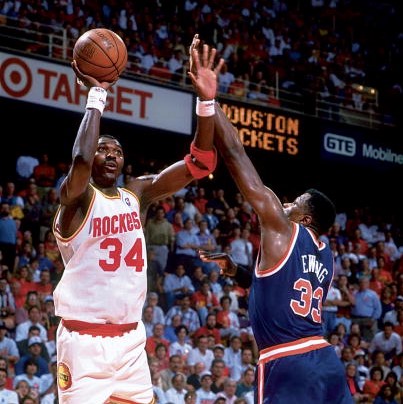
Hakeem Olajuwon #34 of the Houston Rockets shoots the ball in Game 7 of the NBA Finals against the New York Knicks at The Summit, June 22, 1994. /VCG
Hakeem Olajuwon #34 of the Houston Rockets shoots the ball in Game 7 of the NBA Finals against the New York Knicks at The Summit, June 22, 1994. /VCG
Then why didn't Ewing win anything?
For starters, Ewing lacked killer moves on offense. He was agile, strong, he could shoot in the middle range, but Ewing could not destroy the opponents' defense like Olajuwon or O'Neal. On defense, he was almost perfect individually, but the Knicks as a team relied on the guidance of Pat Riley.
Second, Ewing was just unlucky. Meeting Jordan five times in the playoffs aside, in his first NBA Finals trip in 1994, Ewing met Olajuwon who only performed like a true leader for three years in his career. In the first year he defeated Ewing; in the second one, he beat Robinson and O'Neal.
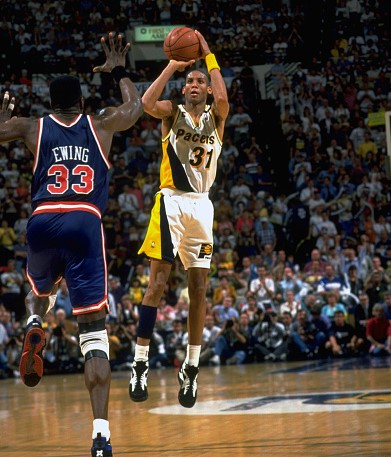
Reggie Miller #31 of the Indiana Pacers shoots the ball in Game 6 of the Eastern Conference Finals against the New York Knicks at Market Square Arena in Indianapolis, Indiana, June 3, 1994. /VCG
Reggie Miller #31 of the Indiana Pacers shoots the ball in Game 6 of the Eastern Conference Finals against the New York Knicks at Market Square Arena in Indianapolis, Indiana, June 3, 1994. /VCG
In 1995, the Knicks met the Indiana Pacers in the Eastern semifinals. Then Ewing experienced the greatest "Reggie Miller Moment" in person – the Pacers' ace shooter scored eight points in 8.9 seconds to help his team win Game 1 before knocking out the Knicks 4-3 in the series.
In 1999, Ewing battled an Achilles tendon injury while dragging the Knicks to the Eastern Finals. Then he was taken out by the injury in Game 2 and had to sit on the bench, watching the Knicks get beat by the San Antonio Spurs led by Robinson and a 23-year-old, second-year rookie named Tim Duncan.
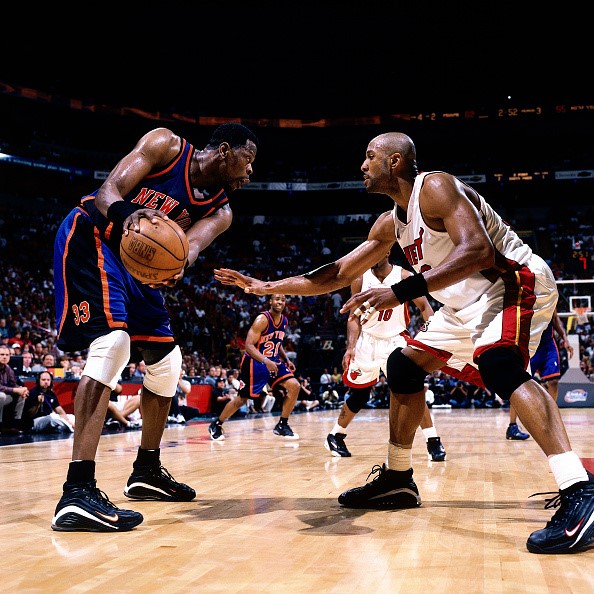
Patrick Ewing (L) of the New York Knicks faces Alonzo Mourning of the Miami Heat in the game at the American Airlines Arena in Miami, Florida, 2000. /VCG
Patrick Ewing (L) of the New York Knicks faces Alonzo Mourning of the Miami Heat in the game at the American Airlines Arena in Miami, Florida, 2000. /VCG
One year later, Ewing and New York met Miller and Indiana again in the Eastern Finals. Then in the fourth quarter of Game 6, Miller dropped 17 points himself, eliminating New York again. As a shooter who finished most his attacks via off-ball moving, catch-and-shooting in the old days, Miller did not have that many highlights in his career, but Ewing experienced two in heartbreaking fashion.
Despite all the losses he's suffered, Ewing deserves more respect than he's received. He is now the head coach of Georgetown University and is currently at home, recovering from COVID-19. Wish this man of steel better health soon.